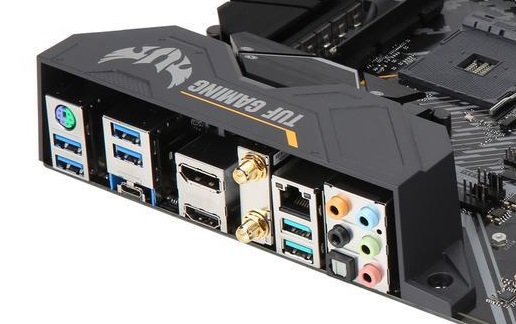The AMD X570 Motherboard Overview: Over 35+ Motherboards Analyzed
by Gavin Bonshor on July 9, 2019 8:00 AM ESTASUS TUF Gaming X570-Plus & X570-Plus WIFI
The ASUS TUF Gaming X570-Plus and TUF Gaming X570-Plus Wi-Fi motherboards both contain the same core componentry with a 12+2 phase power delivery, actively cooled X570 chipset heatsink, a Realtek S1200A HD audio codec, and both feature the new Realtek L8200A Gigabit LAN which is exclusive to ASUS at present. The only difference between the two models is that the TUF Gaming X570-Plus WIFI includes an Intel AC 9260 802.11ac wireless interface with BT 5.0 support included.
On the design, the aesthetic is reminiscent of previous TUF Gaming branded models with a grey and black patterned printing on the PCB, with grey industrial looking heatsinks. There are four memory slots with support for ECC and non-ECC DDR4 memory with a maximum capacity of up to 128 GB. The ASUS TUF Gaming X570-Plus pairing also includes two full-length PCIe 4.0 slots which run at x16 and x16/x4.
Included on the rear panel is an HDMI 1.4b, and DisplayPort video output, with two USB 3.1 G2 Type-A, and one USB 3.1 G2 Type-C port; also featured are four USB 3.1 G1 Type-A ports. A new addition to Realtek's NIC line up and exclusive to ASUS is an L8200A Gigabit NIC, with the WIFI model including an Intel AC 9260 802.11ac wireless interface. The five 3.5 mm audio jacks and S/PDIF optical output are controlled by a Realtek ALC1200A HD audio codec, and finishing off the rear panel is a PS/2 combo port for legacy keyboard and mice.
Both the ASUS TUF Gaming X570-Plus and TUF Gaming X570-Plus WIFI models represent its gaming-inspired entry level; ASUS rebranded the TUF series from durable and robust models, to more accessible models with a more modest outlay when compared to the Strix series. The ASUS TUF Gaming X570-Plus has an MSRP of $170, while the WIFI enabled version is slightly more expensive with an MSRP of $185.












225 Comments
View All Comments
Mr Perfect - Tuesday, July 9, 2019 - link
Yeah, I'm having flashbacks over here. Weedy little fans screaming along at 6000RPM, then choking up on a dust bunny or wearing out the bearing.Do we know what process they used for the X570? Is it the same 55nm they used for the X470? Here's hoping they shrink it a little for X670.
DigitalFreak - Tuesday, July 9, 2019 - link
14nmerotomania - Tuesday, July 9, 2019 - link
55nmDanNeely - Wednesday, July 10, 2019 - link
no. X470 and below were 55nm (designed by ASMedia on an ancient process to keep everything cheap as dirt), X570 was done in house on 14nm. Ryzen 3's IO die is also 14nm (the much larger Epyc one was done at 12nm).erotomania - Wednesday, July 10, 2019 - link
Weedy, man! Those weedy fanssing_electric - Wednesday, July 10, 2019 - link
Given how little chipsets benefit from process shrinks, some part of me honestly wonders if there's any sense in going even further back to the future and dividing the chipset into a north/southbridge (or some other similar config) so that the heat can at least be spread out, getting rid of the need for a failure-prone mechanical part on your motherboard.YoloPascual - Tuesday, July 9, 2019 - link
z77 extreme 4 to x570 extreme 4 👊👊The_Assimilator - Wednesday, July 10, 2019 - link
I also owned a Z77 Extreme 4 at one time, and the X570 version is probably the closest to perfect that I've seen offered so far. If only it had a couple of extra USB ports on the back panel, it'd be a shoe-in.rUmX - Tuesday, July 9, 2019 - link
Hoping for price cuts on Intel cpus because no matter how good Ryzen is, these boards are way too expensive.Karmena - Tuesday, July 9, 2019 - link
Then get X470 or B450 boards. Or even X370 or B350 boards, you are in no way forced to use these latest mobos.